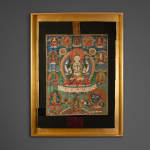Tara Bodhisattva Thangka, 16th Century CE - 18th Century CE
Paint on Fabric
77.2 x 99.1 cm
30 3/8 x 39 in
with frame 88.8 x 118.7 cm
30 3/8 x 39 in
with frame 88.8 x 118.7 cm
RP.139
Tara (Sanskrit तारा) is an important figure in Buddhism, especially revered in Tibetan Buddhism. She appears as a female bodhisattva in Mahayana Buddhism, and as a female Buddha in Vajrayana...
Tara (Sanskrit तारा) is an important figure in Buddhism, especially revered in Tibetan Buddhism. She appears as a female bodhisattva in Mahayana Buddhism, and as a female Buddha in Vajrayana Buddhism. She is known as the "mother of liberation", and represents the virtues of success in work and achievements. She is known as 多羅菩薩 in Chinese Buddhism. Within Tibetan Buddhism Tara is regarded as a bodhisattva of compassion and action. She is the female aspect of Avalokiteśvara and in some origin stories she comes from his tears. Tara is a meditation deity revered by practitioners of the Tibetan branch of Vajrayana Buddhism to develop certain inner qualities and to understand outer, inner and secret teachings such as karuṇā (compassion), mettā (loving-kindness), and shunyata (emptiness). Tara may more properly be understood as different aspects of the same quality, as bodhisattvas are often considered personifications of Buddhist methods. There are many forms of Tara, including various popular lists of 21 different emanations of Tara. Among the various forms, the White Tara, (Sitatārā) with two arms seated on a white lotus and with eyes on her hand and feet, as well as a third eye on her forehead (thus she is also known as "Seven eyed"). She is known for compassion, long life, healing and serenity. (RP.139)



